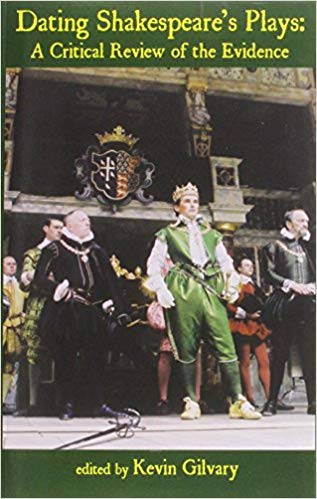 March 13, 2019 — Kevin Gilvary’s edited collection, Dating Shakespeare’s Plays, originally published in book form in 2010, is now available online here, in a series of downloadable files, one for each of the 36 plays in the First Folio, plus essays on four other plays. (Update: The book is also now available from Portsea Press.)
March 13, 2019 — Kevin Gilvary’s edited collection, Dating Shakespeare’s Plays, originally published in book form in 2010, is now available online here, in a series of downloadable files, one for each of the 36 plays in the First Folio, plus essays on four other plays. (Update: The book is also now available from Portsea Press.)
As Gilvary notes, “Dating Shakespeare’s Plays has been a collaborative enterprise, involving methodical research by over twenty scholars, brought together in a uniform and accessible format.”
Gilvary received the SOF’s 2011 Oxfordian of the Year award for his work on the project. “It has been my honour and my pleasure to edit this work,” he says. He also thanks the SOF’s webmaster, Jennifer Newton, for her fine work in creating the website for the new online version.
The book’s thorough introduction offers a conceptual framework in which a clear distinction is drawn between (1) the date of a play’s composition, (2) the date of its premiere, and (3) the date of its earliest publication. Historically, the tendency among scholars has been to assume that the playwright produced one definitive version of each play, which was then handed over to the acting companies for immediate performance, before finding its way quickly to publication in quarto or, later, in the First Folio of 1623.
More recently, there has been a growing awareness that a play might have been written well before its first performance or its appearance in quarto. Furthermore, the author probably revised and expanded some plays, such as King Lear. Thus, two or three versions might have comparable authorial status. For example, the most recent editors of Hamlet for the Arden series accept that the three versions of the play (First and Second Quartos and First Folio) might all have come from the playwright himself, so by “the date of a play,” we might possibly be referring to nine different dates.
Each essay considers not only the evidence for dating that play but also every argument used in support of a preferred date. For each play, there is (a) publication data, such as entries in the Stationers’ Register or statements on the title pages, (b) performance data, such as contemporary allusions in the Revels Accounts or Henslowe’s Diary, (c) dates of all sources, both probable and possible, and (d) allusions to the play in contemporary accounts, diaries, poems, and the like.
In reviewing the “orthodox dates,” each chapter begins with analysis of the cautious proposal of Edmund K. Chambers (1930), the arguments of Wells and Taylor (1987), and the dates assigned in the major editions of the Arden Second and Third Series, the Oxford Shakespeare, and the New Cambridge Shakespeare. Reference has also been made to the dates assigned by Martin Wiggins et al. in their multi-volume British Drama, 1533–1642.
The findings are necessarily inconclusive: it is only possible to establish a date range for each play. As scholar after scholar has acknowledged, the evidence to fix a precise year for any particular play is simply lacking. Thus, Dating Shakespeare’s Plays is different from previous efforts in this field by simply identifying the range of dates for each play, rather than arguing for a particular date. In considering Oxfordian dates, the intention is not to prove that Edward de Vere (17th Earl of Oxford) wrote the works. Rather, the purpose is to consider whether alternative, often earlier, dates for the plays are tenable.
[originally published March 13, 2019, revised and updated Feb. 2021]


